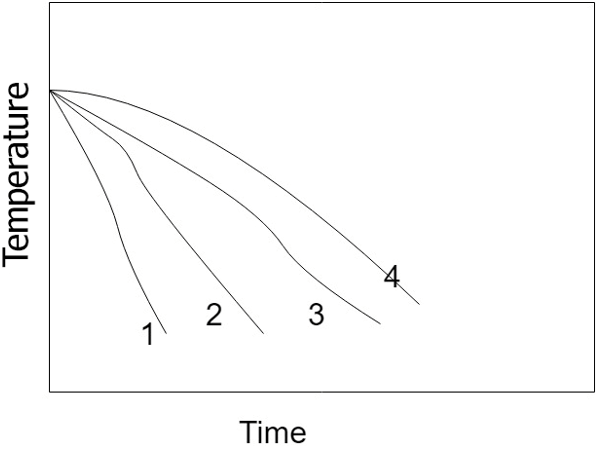This set of Heat Treatment of Metals and Alloys Multiple Choice Questions & Answers (MCQs) focuses on “Steels – Continuous Cooling Transformation”.
1. Which one of the following statements is correct for CCT curves?
a) It is drawn at isothermal conditions
b) It is drawn at varying cooling rates
c) It is drawn by quenching treatment
d) It is drawn at constant cooling rate
View Answer
Explanation: The CCT curve is drawn at a given constant cooling rate. Here, transformation times are noted using constant cooling rates.
2. Which one of the following statements is incorrect for CCT diagrams?
a) Pearlite is formed
b) Martensite is formed
c) Bainite is formed
d) Bainite is not formed
View Answer
Explanation: In CCT diagrams, bainite is not formed. The reason behind this is that in the case of CCT curves, continuous cooling is done. Bainite cannot be formed by continuous cooling.
3. Which one of the following curves denote highest cooling rate?

a) 1
b) 2
c) 3
d) 4
View Answer
Explanation: Curve 1 has the highest cooling rate. If we draw a tangent at any point on curve 1 we will get the steepest tangent as compared to others.
4. Which one of the following curves represents full annealing for eutectoid steel?

a) 1
b) 2
c) 3
d) 4
View Answer
Explanation: Curve 4 represents full annealing. It has a much slower cooling rate than other heat treatment processes.
5. Which one of these curves represents normalizing?

a) 1
b) 2
c) 3
d) 4
View Answer
Explanation: Curve 3 represents Normalizing. Normalizing process has a higher cooling rate than full annealing. It is also more economical than annealing.
6. If curve 1 represents water quenching, then what does curve 2 represent?

a) Splat quenching
b) Oil quench
c) Melt spinning
d) Air cooling
View Answer
Explanation: Curve 2 represents an oil quench. Its cooling rate is less than water quench and greater than normalizing.
7. What is the final product obtained after the oil quench?
a) Martensite
b) Martensite + Pearlite
c) Fine pearlite
d) Coarse pearlite
View Answer
Explanation: The final product for oil quenching is martensite + pearlite. In the case of full annealing, because of slower cooling rate it is coarse pearlite. For normalizing it is fine pearlite courtesy to higher cooling rate.
8. Which one of the following processes has the highest cooling rate?
a) Water quenching
b) Oil quenching
c) Splat quenching
d) Melt spinning
View Answer
Explanation: Melt spinning has the highest cooling rate. For eutectoid steel, it is 106-108 K/s. For water quenching, oil quenching and splat quenching it is 500K/s, 100K/s, 105 K/s respectively.
Sanfoundry Global Education & Learning Series – Heat Treatment of Metals and Alloys.
To practice all areas of Heat Treatment of Metals and Alloys, here is complete set of Multiple Choice Questions and Answers.
If you find a mistake in question / option / answer, kindly take a screenshot and email to [email protected]
